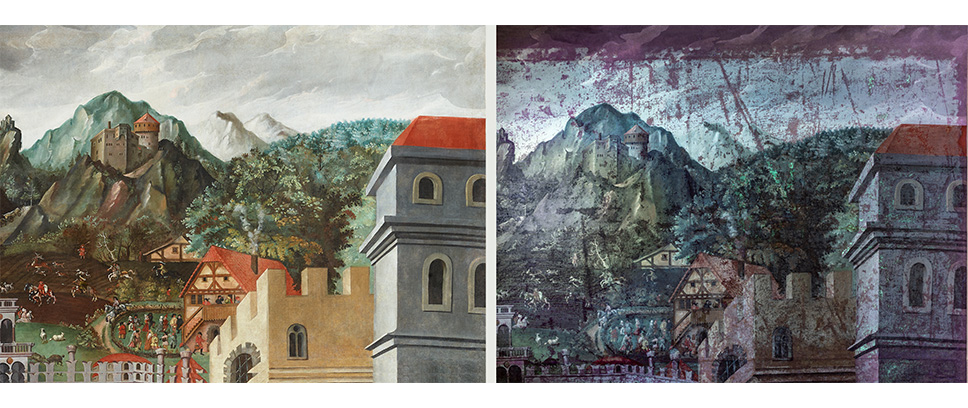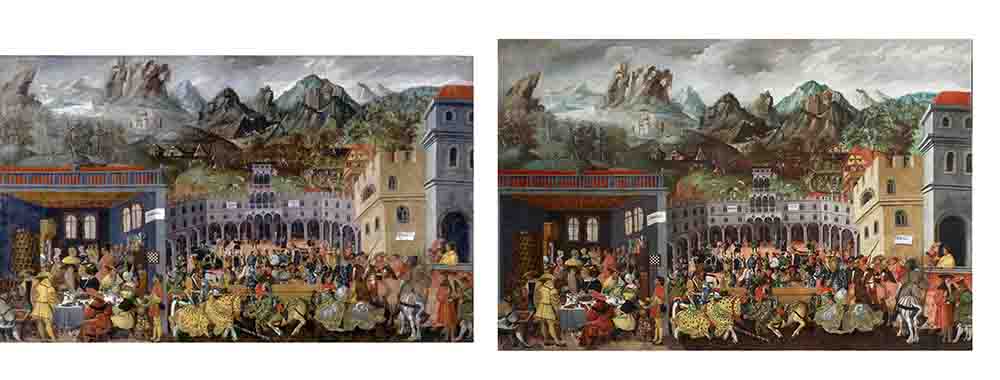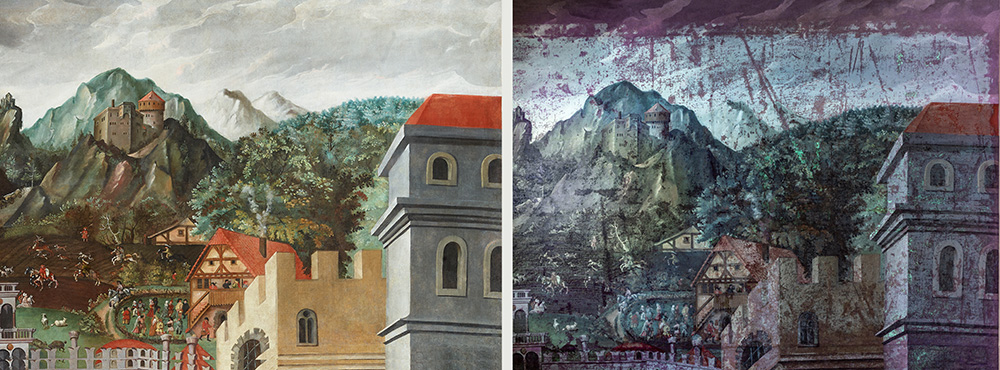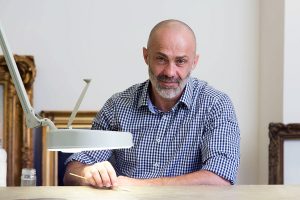
From Idea to Realisation – Interview with Mathias Lang
25. September 2024
With the exhibition “Dive into the Picture! Time Travel for Kids” the Deutsches Historisches Museum is showing an inclusively designed exhibition primarily for children of grade school age. It is based on the Picture of the Month “January – February – March”, which belongs to the famous seasonal cycle of the so-called “Augsburg Pictures of the Months” from the 16th century, one of the most important artworks in the DHM collections. Here the world of 500 years ago unfolds before us as if we were entering a 3-D walk-in backdrop. The people portrayed in the painting emerge into the exhibition room as historical figures who tell their stories and invite the young guests to explore and experience the world of the 16th century.
In our interview series we speak with the people and teams that have made this exhibition possible through their ideas and expertise. In this interview, painting restorer Mathias Lang talks about the central element of the exhibition – the so-called Augsburg picture of the months “January – February – March”.
„The many tiny figures, people, and animals that are found all over the painting are particularly well done, simply off the cuff, precise and jaunty and painted with only a few strokes of the brush.“
Mathias Lang, painting restorer at DHM
The centrepiece of the exhibition is one of the four Augsburg Pictures of the Months – a highlight of the DHM collection. Each of the four paintings represents a season, whereby the winter picture is the centre of this exhibition. In the past years you have occupied yourself intensively with the paintings, their contents, but above all their artistic execution. What is the special thing about the pictures for you personally?
When the pictures were bought in the 1990s and came to our house, they were attributed to Jörg Breu the Elder. After intensive research and comparison with other pictures, we determined that we can dispense with this assumption. The Pictures of the Months do not have the same painterly quality, which is top-class in the case of Breu. The pictures in the DHM collection have a different method of painting that is very “efficient”, from which we can assume that they were painted fairly quickly. And we can imagine that several different artists were assigned to deal with different topics – with the landscapes, for example, or with the figures and faces. Here, too, there are differences in the quality and stylistic concepts. Evidently the artists involved in the work were not all equally talented. The many tiny figures, people, and animals that are found all over the painting are particularly well done, simply off the cuff, precise and jaunty and painted with only a few strokes of the brush. That gets lost in the sheer grandeur of the painting – but thrills me and my colleagues especially. That led to the idea of using field glasses for the kids in the exhibition so that they are better able to experience these little “artistic treasures” from a distance. During the whole time when my colleagues and I have been working on the pictures, there has always been something new to discover that the artists have lovingly painted and often with a certain humour. There are miniature depictions of a “lover’s tryst”, of a man who, no doubt after imbibing a bit too much wine, relieves himself out of a window, and many more such scenes. So the painting has something very special in the stories it tells and not always in its artistic execution.

Why did the painting cycle have to be restored? What measures did you undertake?
After the paintings were bought in the 1990s, they were restored for a pending exhibition in Augsburg under the title “Pastime without measure and aim”. They were in very bad shape. Over the centuries they had been rolled up, bent and folded. This had led to a loss of painting. The damage had been repaired in different phases. Missing parts had been added by retouching and overpainting. A doubling had been carried out, meaning that the canvas had been reinforced by pasting on a new one underneath it. The formats of all the pictures had been changed when they were cut out of the walls, and new edges had been formed by gluing on strips of canvas. The restoration of the pictures had consisted of removing dark layers of varnish (a glossy finish) and of old retouched areas where the colour had changed as well as the removal of overpainting. Loose layers of paint were stabilised. Missing parts of the painting were cautiously improved through so-called line technique (tratteggio).
The preparations for the new Permanent Exhibition raised the question of new decorative frames and how the paintings could be displayed in temporary frames before the new ones were ready. Because it can be assumed that they were originally displayed in wall panelling, a Renaissance architectural framing was designed on the basis of contemporary models that would reflect the assumed form of display. Parts of the original painting still existed on the clamping edges and could be used for the areas of the picture that had to be reconstructed. Within the framework of these measures, sections of the painting were refined by means of line technique. During a previous restoration campaign, this had already been started in the lower areas of the painting. That gave us an advantage for the details of the painting that can now be better perceived.

What research findings have been discovered during the restoration process?
The original authorship is still unknown. The attribution to Jörg Breu the Elder and his workshop can no longer be maintained. Based on the painting technique and the materials used, we can assume that the picture was not made in 1531, as had earlier been believed, but more likely in the second half of the 16th century.
The paintings all use the same technical structure, first a white grounding followed by a grey layer on which it was then painted. Stylistically, it appears that two pairs of pictures are more similar to one another. The implementation of perspective and the use of light and shadow are particularly “modern” above all in the painting “July-August-September” which has an almost baroque-like style. Only further study of the actual provenance of the pictures can lead to more insight into their authorship and origin. This has been exacerbated by the destruction of archives during the Second World War.
|
Foto: Thomas Bruns |
Mathias LangMathias Lang is painting restorer at Deutsches Historischen Museum. |
